
- No top tier US labour market data released this week
- Fedspeak likely to be dovish while talking up economic outlook, potentially helping to boost riskier asset classes
- Australian calendar dominated by RBA rates decision, monthly CPI indicator
- Ueda speech, Tokyo inflation key events in Japan
- USD/CNH hits multi-year lows, underpinning sentiment in emerging market FX
No (major) news is good news?
With no major US labour market data released this week, it will be left up to central bank commentary, PMI reports, bond auctions and quarter-end flows to dictate direction. Put together, unless we see evidence of an alarming deterioration in activity from major developed nations, the combination points to an environment where riskier asset classes may outperform.
For AUD/USD and USD/JPY, we may therefore continue to grind higher, building on the move that began in mid-September. One pair to keep an eye on if you’re trading Asian or emerging market currencies is USD/CNH which has broken lower despite ongoing weakness in Chinese economic data.
US calendar devoid of major risk events
With the Federal Reserve keeping a close eye on incoming labour market data, traders need to be aware of risk events that could materially shift current market expectations that look for 83 basis points worth of cuts by the end of this year.
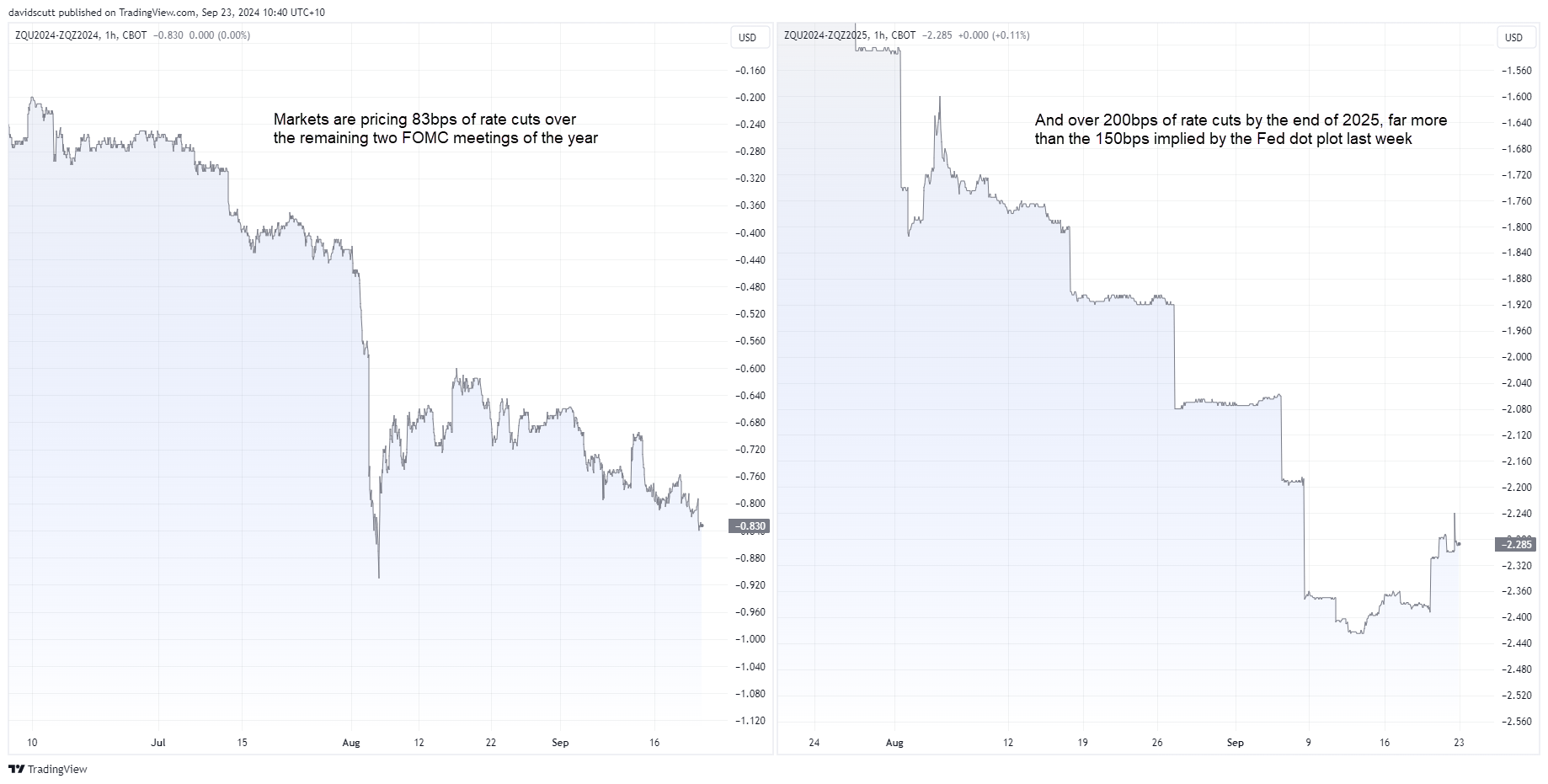
Looking at the US calendar, there’s few events this week that screen as potential major market movers. Yes, there are plenty of Fed speakers, including Jerome Powell, but with all bar one FOMC member voting for a 50 basis point rate cut last week, it’s a safe bet the tone will be dovish while continuing to talk up the probability of delivering a soft economic landing.
The data flow is also busy but few screen as being important. Of those traders should be aware of, the S&P Global flash PMIs on Monday, Tuesday’s Conference Board consumer confidence report, especially measures on labour markets, along with jobless claims on Thursday, are events that could generate volatility.
Friday’s PCE report is arguably the most important release, although rather than the inflation measure, it could be the strength of incomes and consumption growth that may garner more attention given the implications for growth and hiring.
For yield sensitive FX pairs like USD/JPY, Treasury auctions of two, five and seven-year notes on Tuesday, Wednesday and Thursday respectively, should also be watched for evidence of shifts in demand after recent declines in yields.
With the quieter US calendar, traders may want to place more emphasis on international event risk and signals from price action this week.
RBA, inflation indicator in focus for AUD traders
For AUD/USD, the Australian calendar is dominated by the Reserve Bank of Australia (RBA)’s September interest rate decision, although it’s the tone that will be in focus given it’s a near-certainty the cash rate will be remain at 4.35%.
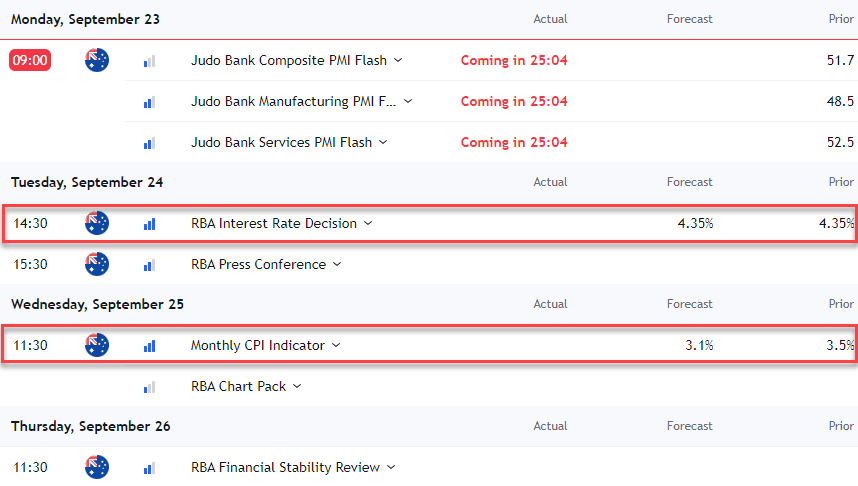
Despite the Fed’s 50 basis point rate cut last week, it’s unlikely the RBA will signal a similar move anytime soon given strength in labour market conditions and uncertainty surrounding the inflation outlook. It’s likely to repeat that it remains “vigilant to upside risks to inflation” and “not ruling anything in or out” regarding the rate outlook. My sense is it needs to see either a sharp lift in Australia’s unemployment rate, a global crisis, or at least two subdued quarterly consumer price inflation reports before it considers rate cuts.
On Wednesday, Australia’s monthly inflation indicator will be released, containing more information on services prices which is what the RBA is more concerned about. While the headline annual rate may fall back into the RBA’s 2-3% inflation band, that will be largely driven by one-off electricity subsidies. Unless there’s concrete evidence of cyclical factors helping to lower inflation, the RBA has made it clear that it’s putting more weight on signals from underlying readings such as the trimmed mean measure.
AUD/USD squeezing higher
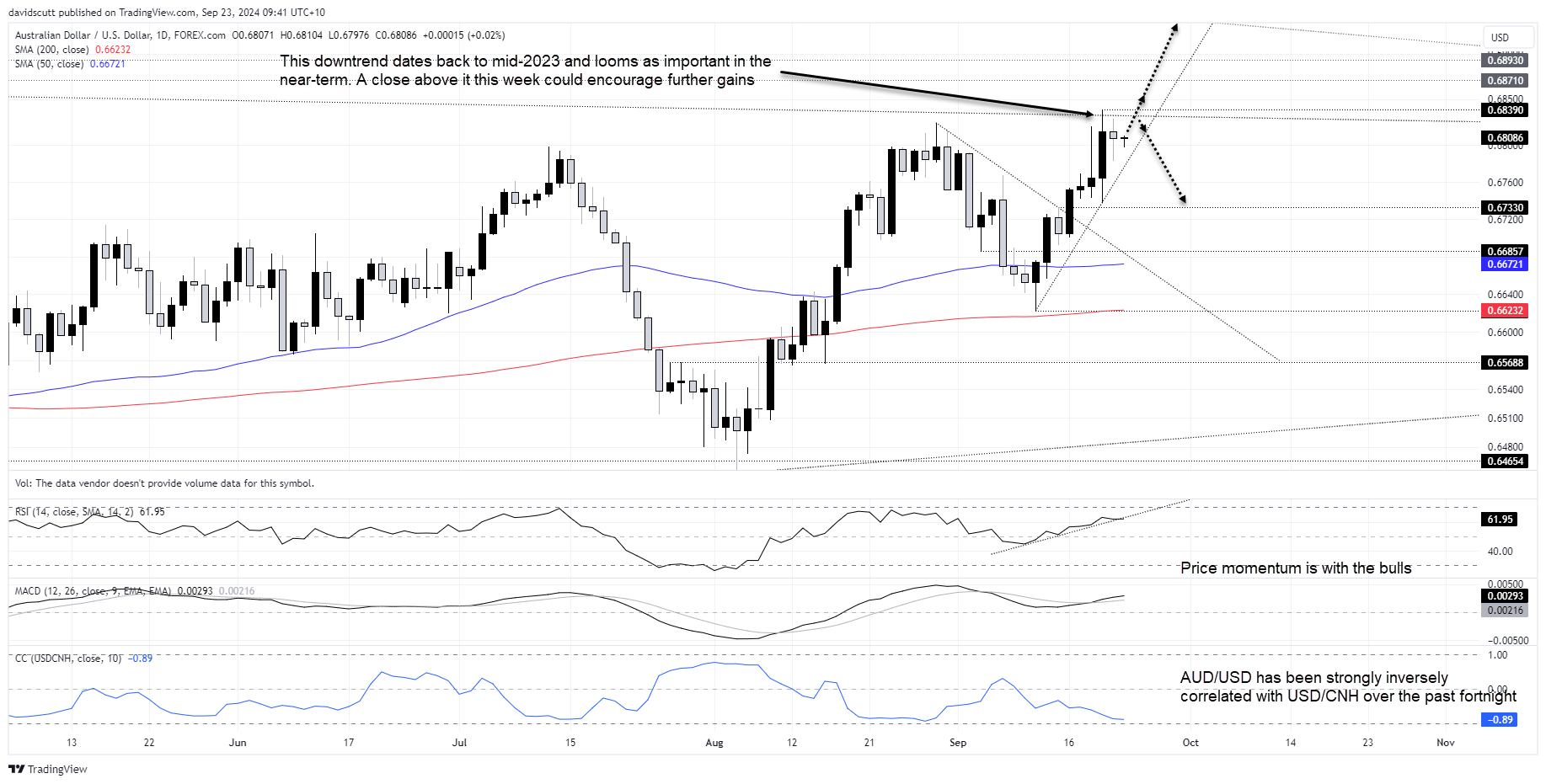
On the daily chart, AUD/USD remains sandwiched between uptrend support and key downtrend resistance dating back to the middle of 2023. With momentum indicators such as MACD and RSI (14) providing bullish signals, you get the sense that if AUD/USD can break and close above the downtrend, the prospect of stop-loss buying and traders buying the break could send it to fresh multi-year highs.
Today, the downtrend is located at .6833. Above, .6839, .6871, .6893 are initial levels of note. Should it be unable to get a foothold above the downtrend, .6733 and .66857 acted as minor support and resistance in the recent past should uptrend support give way.
On the bottom pane, I’ve included the rolling 10-day correlation AUD/USD has with USD/CNH, demonstrating that when the Chinese yuan strengthens and weakens against the US dollar, the Australian dollar has often done the same over the past fortnight.
USD/CNH breaks lower, underpinning EM FX
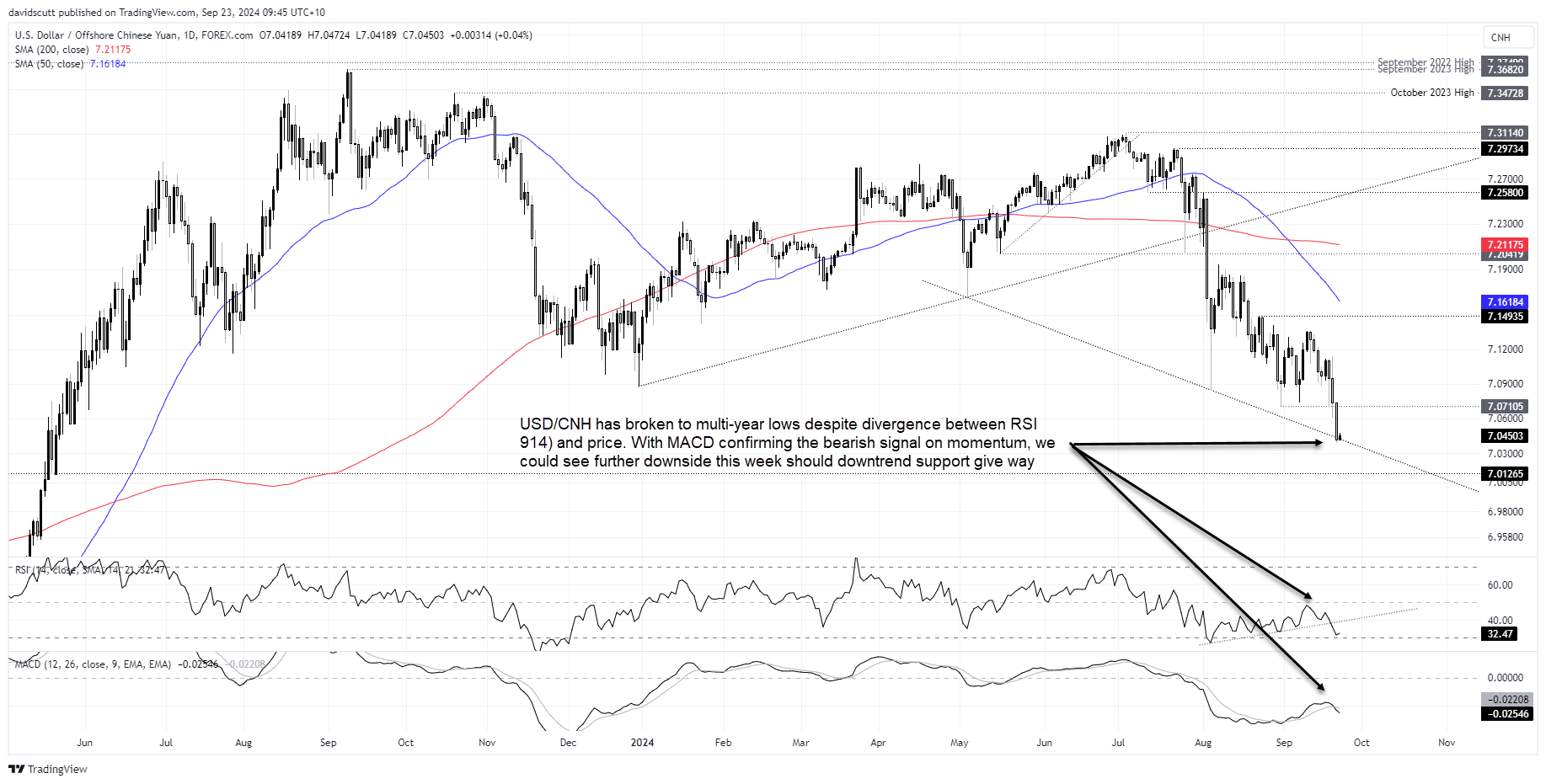
It hasn’t received fanfare in markets, but USD/CNH broke to multi-year lows last week, making you wonder whether it’s a sign AUD/USD may do the same on the topside before too long.
With USD/CNH testing downtrend support around 7.04250 today, and with RSI (14) and MACD generating bearish signals on momentum, we could see more downside this week, opening the door for a push towards 7.01265.
Considering they are often extremely correlated, it’s interesting USD/JPY is moving in the opposite direction to USD/CNH right now, pushing higher while the latter plumbs fresh lows. Perhaps the divergence reflects the reemergence of carry trades given optimism towards the global economic outlook is spurring gains in riskier asset classes?
Whatever the reason, we know shifts in the US rate outlook continue to be influential on USD/JPY movements, making Japanese risk events secondary in consideration for traders.
Japanese calendar relatively quiet
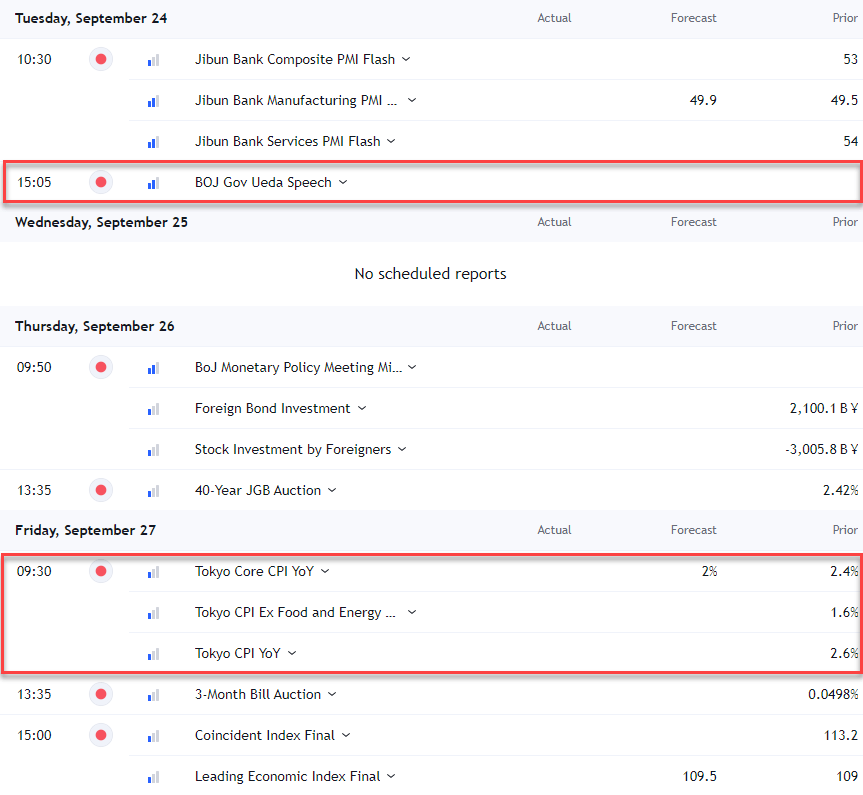
After BOJ Governor Ueda suggested he was not in a rush to lift policy rates further given the risk of an inflation overshoot had diminished due to recent yen strength, there’ll be focus on his speech on Tuesday. However, unless he wants to meaningfully correct market interpretation, it’s difficult to see how his views could change materially in the space of a few days.
Friday’s Tokyo area consumer price inflation is the only other event for traders to watch, although in the past it has not generally delivered significant market movement unless we see a large deviation away from consensus. Such a scenario is rare.
USD/JPY looking bullish
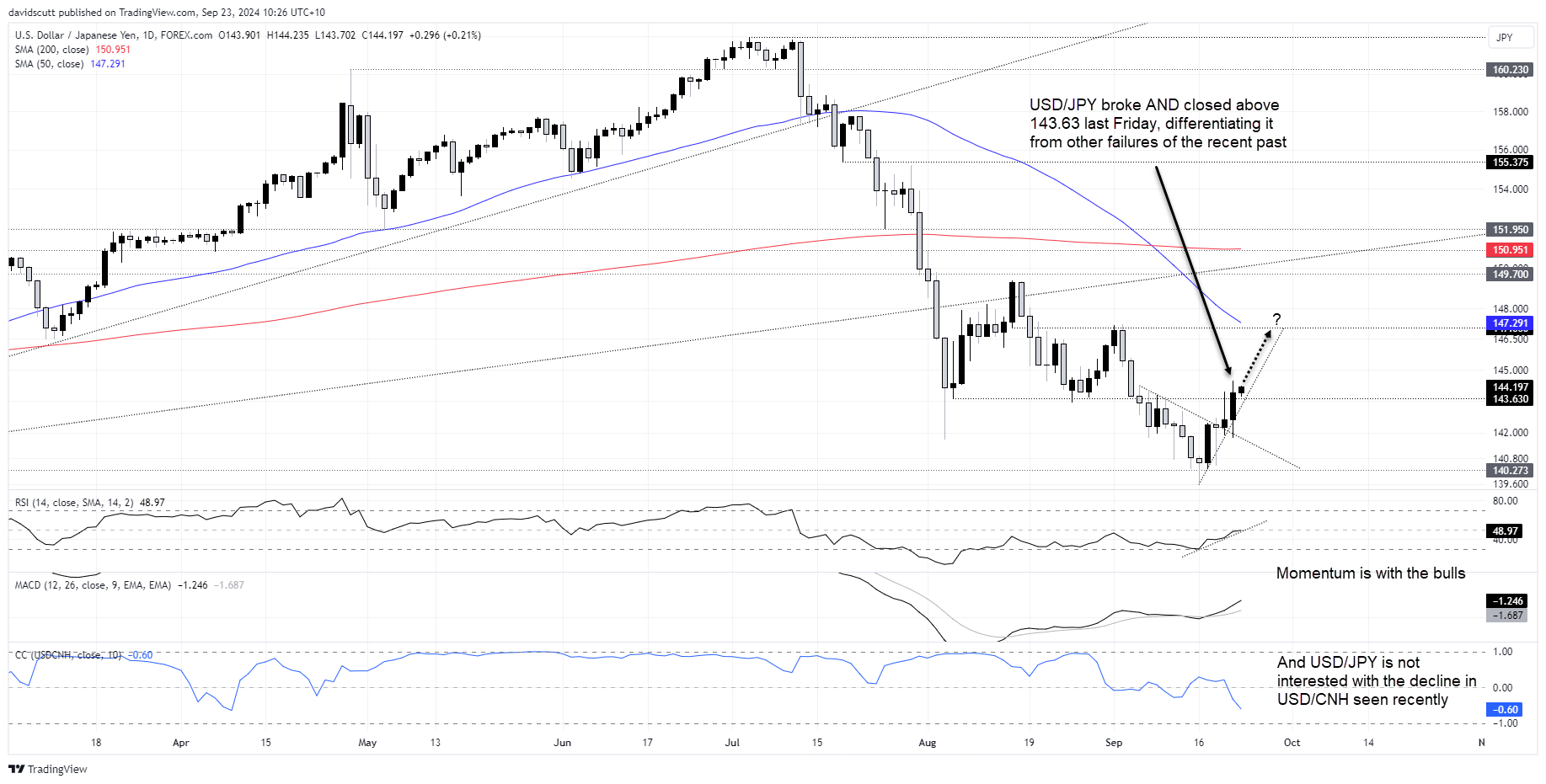
Looking at USD/JPY on the daily chart, the hammer candle last Monday set the tone last week, seeing the price not only break minor downtrend resistance but also close above 143.63, something it had been unable to achieve since early September despite several attempts to do so.
If able to push above Friday’s high of 144.50, it could see the price retest resistance above 147.06 given MACD and RSI (14) continue to provide bullish signals on momentum. And when you zoom out, you can’t help but notice the key reversal candle on the weekly chart, adding to the bullish near-term picture.
-- Written by David Scutt
Follow David on Twitter @scutty






